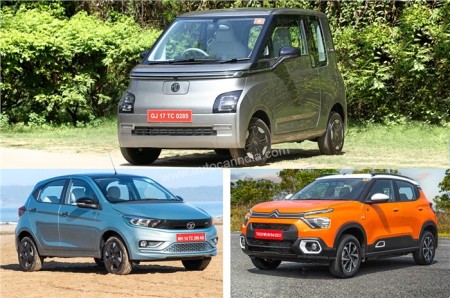MG Comet price Tata Tiago EV range charging ride features and performance – Introduction
CarNews
On paper these two EVs have a similar price and range, so we find out which one is the better pick.
The MG Comet is India’s most affordable electric hatchback in India, priced between Rs 7.98 lakh-9.98 lakh, available with a 17.3kWh battery. We’ve examined this radical two-door, four-seater EV and put it through our instrumented tests to find out how it performs in the real world. To bring in some perspective, we compare it with the similarly priced Tata Tiago EV.
Tata’s electric hatchback is available in a wider range with two variants – the MR version gets a 19.2kWh battery priced between Rs 8.69 lakh-9.29 lakh, and the LR version gets a 24kWh battery priced between Rs 10.24 lakh-11.54 lakh.
MG Comet vs Tata Tiago EV: design
Spawned on a dedicated electric platform, the MG Comet features an unorthodox monovolume, cube-like silhouette that oozes with character, thanks to its quirky styling, chunks of chrome and stunning LED light bars (front and rear). It is India’s smallest (in length) passenger vehicle too. For reference, it is 795mm shorter in length, 172mm narrower in width and its wheelbase is 390mm shorter than the Tata Tiago EV; and being a tallboy, it is 104mm taller.
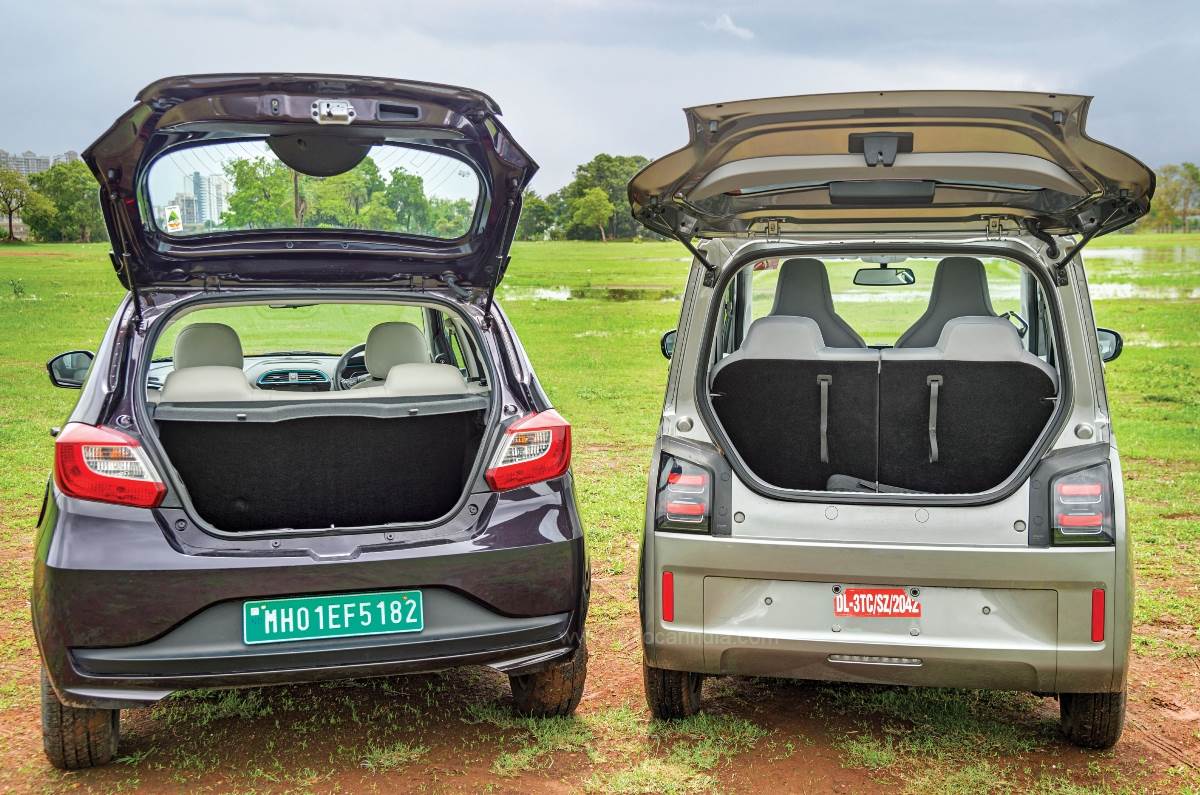
Tiago’s 240L boot is more accomodating and usable; the MG’s can only fit a laptop bag at best.
The Tiago EV with its conventional two-box design, which is otherwise a handsome looker, appears dated when parked beside the radical MG.
MG Comet vs Tata Tiago EV: interior
Futuristic, minimal and pleasant are adjectives that best describe the Comet’s interior. The white colour scheme and massive greenhouse area elevate its sense of spaciousness, and the twin screens lend it an upmarket feel. Truly impressive is the overall feel of the beautifully built cabin, with high-quality bits in most areas.
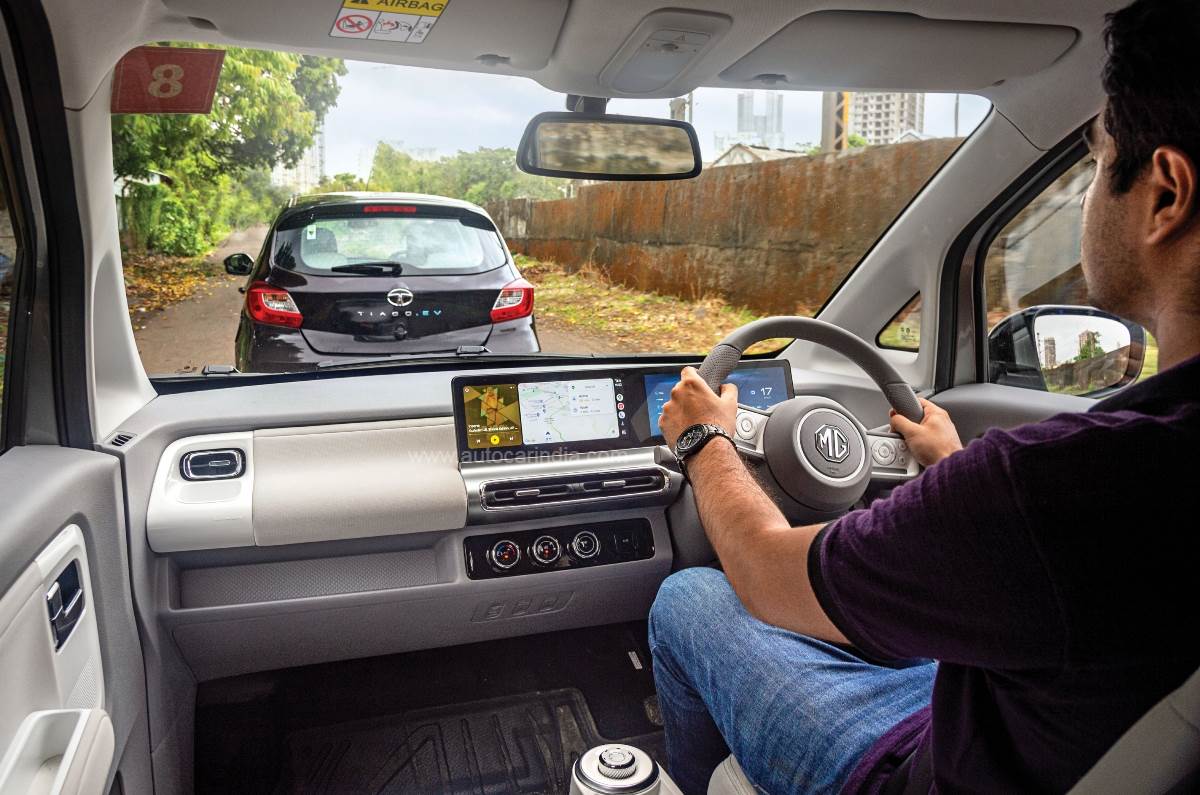
The MG’s minimalistic interior looks and feels great; storage spaces limited.
What comes as a revelation is the space on offer, especially keeping its tiny footprint in mind. Comfort though isn’t its strong suit – its front seats have limited adjustment and the seats aren’t supportive due to a short squab. The doors open wide and with the pull of a lever, the front seats fold and slide forward to ease access to the rear seat. Its rear bench is surprisingly spacious for two adults with ample knee and headroom, albeit the seat is low-set, so passengers are in a knees-up position, and even though its rear windows don’t open, the tall, aircraft-style windows brighten the ambience.
Storage areas are limited; there is neither a glovebox nor a dedicated place to stow your smartphone securely, and its boot is tiny and can haul only a slim laptop bag, with the third row in place.
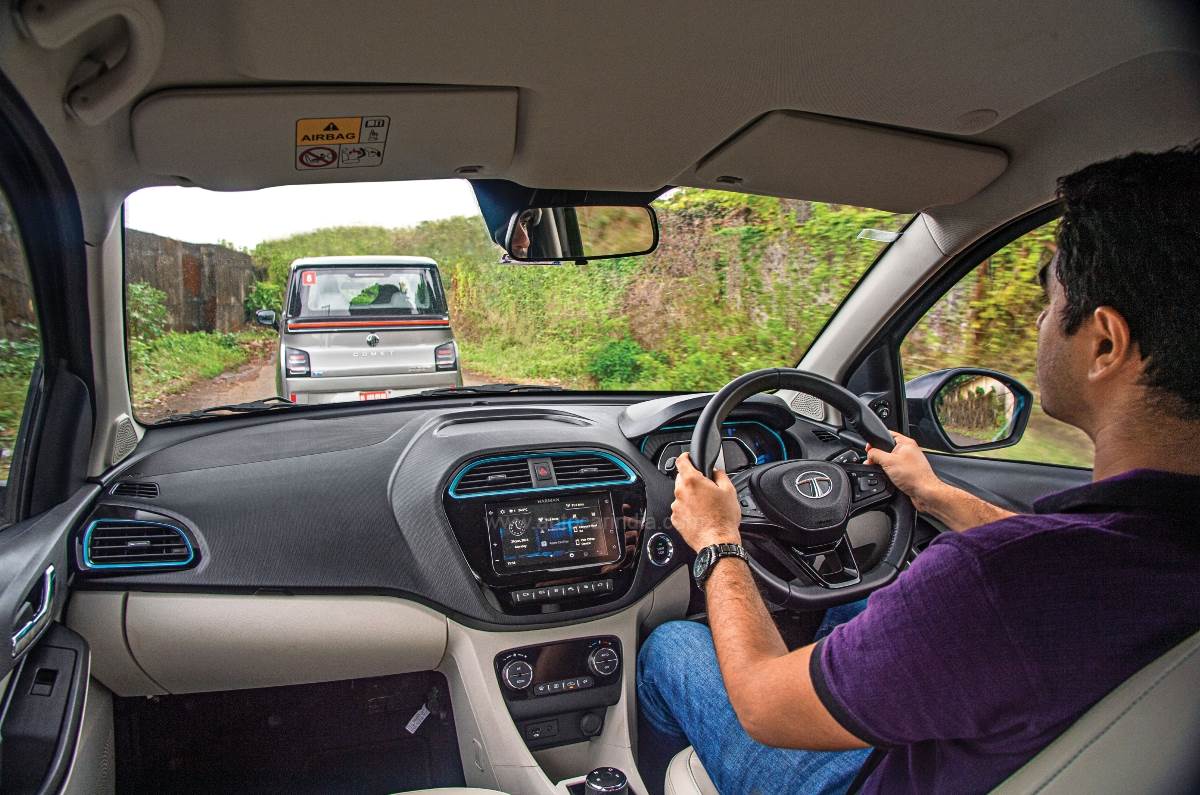
Albeit a bit dated, the Tiago’s interiors are comfier and more practical.
The Tiago EV’s interiors are solidly built and reek of an air of quality. However, like its exteriors, its cabin feels bland and dated compared to the MG, particularly due to its puny digital speedo and its 7-inch touchscreen. Its seats are comfier though, and rear seat passengers have the luxury of a dedicated set of doors too. Interestingly, knee room in the Tata feels similar to the Comet EV’s, and even though the seat is relatively wider – and the Tiago EV is technically a 5-seater – three adults abreast will be a tight squeeze.
The Tiago EV’s cabin is a lot more practical with better-designed storage areas, and at 240 litres, its boot is much more accommodating too. Neither car gets a spare tyre; instead they get a puncture repair kit as standard
MG Comet vs Tata Tiago EV: features
The highlight of the MG Comet is its 10.25-inch twin-screen set up – one for the instrument cluster and the other for infotainment. The latter is packed with connected car tech as well as wireless Android Auto and Apple CarPlay, however, it gets just two speakers, and sadly, it will leave you wanting for better sound quality. The Comet also features a stunning set of LED light bars in the front and at the rear. Appreciably, its LED headlamps are excellent with a fantastic throw and spread. What the Comet also gets over the Tiago EV is a hill-hold function.
| Equipment checklist | ||
|---|---|---|
| MG Comet Plush | Tata Tiago EV XZ+ Tech Lux | |
| LED headlamps | Yes | NA |
| Auto headlamps | NA | Yes |
| Alloys | NA | NA |
| Touchscreen | 10.25-inch | 7-inch |
| Android Auto/ Apple CarPlay | Wireless | Wired |
| Number of speakers | 2 | 8 |
| Leatherette seats | NA | Yes |
| Cruise control | NA | Yes |
| Drive modes | Yes | Yes |
| Electric folding mirrors | NA | Yes |
| Rear wiper and washer | NA | Yes |
| Auto climate control | NA | Yes |
| Hill-hold assist | Yes | NA |
| ESP | NA | NA |
Kit that the Comet EV misses out on are auto headlamps, automatic climate control, leatherette upholstery, cruise control, rear wiper and washer, electric folding mirrors as well as an 8-speaker Harman system with sound quality eons ahead of the MG. The Tiago EV also supports DC fast charging, which the MG misses. So even though the Tata costs Rs 1.56 lakh more, the additional kit easily justifies the premium.
MG Comet vs Tata Tiago EV: performance
With its tinier footprint, upright driving position, better frontal visibility and its ability to turn on a coin thanks to a turning radius of just 4.2m, the MG Comet EV does a convincing job as an urban runabout. It will merrily chug along with the flow of traffic, and there are three driving modes – Eco, Normal and Sports, with performance in Eco being dull, and Normal and Sports being relatively livelier. Its motor is quite vocal and at 42hp/110Nm, its specs are modest at best. Expectedly, performance within city confines feels just about adequate. But demand anything more and you will be left wanting for more zing. On the other hand, the Tata’s 74hp motor feels a lot more responsive and performance feels zippier and more effortless in comparison.
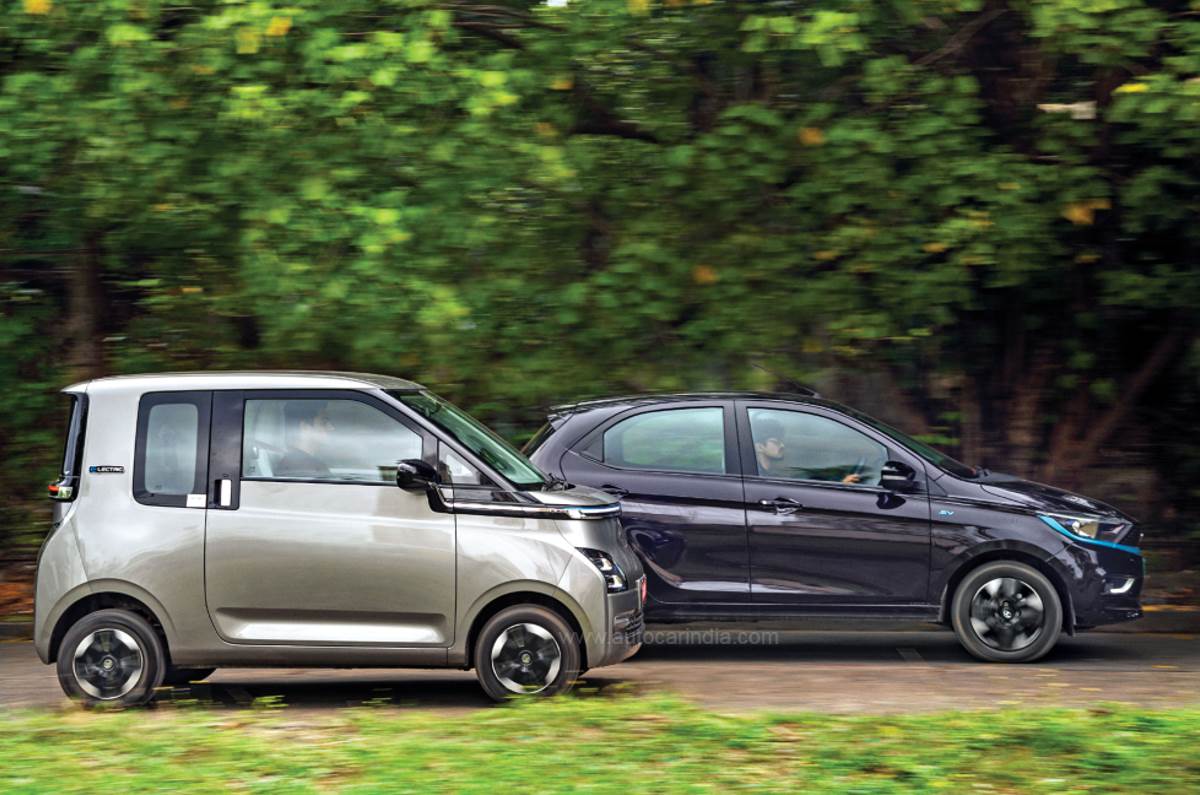
Tiago EV feels zippier and performs far more effortlessly.
The Tiago EV gets two drive modes – City where max torque is limited to 75 percent, and Sport, which unlocks the motor’s full potential. Interestingly, the Tiago EV’s acceleration from 0-60kph in City mode is identical to the Comet’s Sports mode, but from thereon, the Tiago EV shoots into the lead to 100kph, by over 6 seconds. Switch to Sport mode in the Tiago EV, and it outdrags the Comet from 0-60kph and 0-100kph by nearly 2 and 9 seconds, respectively. The Tata also hits a higher top speed of 120kph, whereas the Comet EV’s is 101kph.
Both cars have three levels of regenerative braking, and while neither can be driven with one-pedal only, as these don’t come to a halt using regen, the Tiago EV gives users the option to turn regen off and let the car roll freely.
Besides livelier performance, the Tiago EV drives in a sportier manner with tighter body control and sharper dynamics. Body movements are few, its relatively larger tyres flatten imperfect road surfaces better, and you don’t feel body roll like the way you would in the MG Comet. On account of its small tyres and limited travel suspension, the Comet’s ride is relatively busier, it crashes over sharp edges, and you will have to contend with prominent body roll even while changing lanes.
MG Comet vs Tata Tiago EV: range and charging
In our instrumented range tests conducted in their most economical setting, the lightweight MG Comet EV (817kg) delivered an efficiency of 11.17km/kWh, much higher than the heavier (1,150kg) Tiago EV’s 7.77km/kWh. As a result, the MG’s 17.3kWh battery can be driven 193km on a full charge, while the Tata’s 24kWh can manage 187km. We must mention that range and efficiency numbers are bound to drop in other modes.
Also noteworthy is that the maximum speed an MG Comet can be charged is 3.3kW, so its battery will take a little over 3 hours to charge from 20-80 percent on an AC fast-charger, and a little over 4.5 hours using a 15A slow charger. In comparison, not only is the Tata Tiago EV far more practical as it supports DC fast charging, its battery will charge from 20-80 percent in an hour at a public fast charger, making it more suitable for occasional long, inter-city drives.
MG Comet vs Tata Tiago EV: verdict
The charming, characterful MG Comet is a breath of fresh air in a market flooded with conventional offerings. Being a two-door, micro-car gives it loads of appeal. What’s more, its interiors are beautifully built, its cabin is surprisingly spacious for its size, and its range of 193km is rather good.

But for similar money, the Tata Tiago EV is fundamentally a better car – it drives nicer, is better equipped and is much more practical, not only because it has rear doors but also because it has a larger, more usable boot, and the fact that it supports DC fast charging.
All factors considered, our vote goes to the Tata Tiago EV, which has a wider appeal for its well-roundedness and practicality, however, as a secondary urban runabout, the quirky and cool Comet is worth your consideration.
